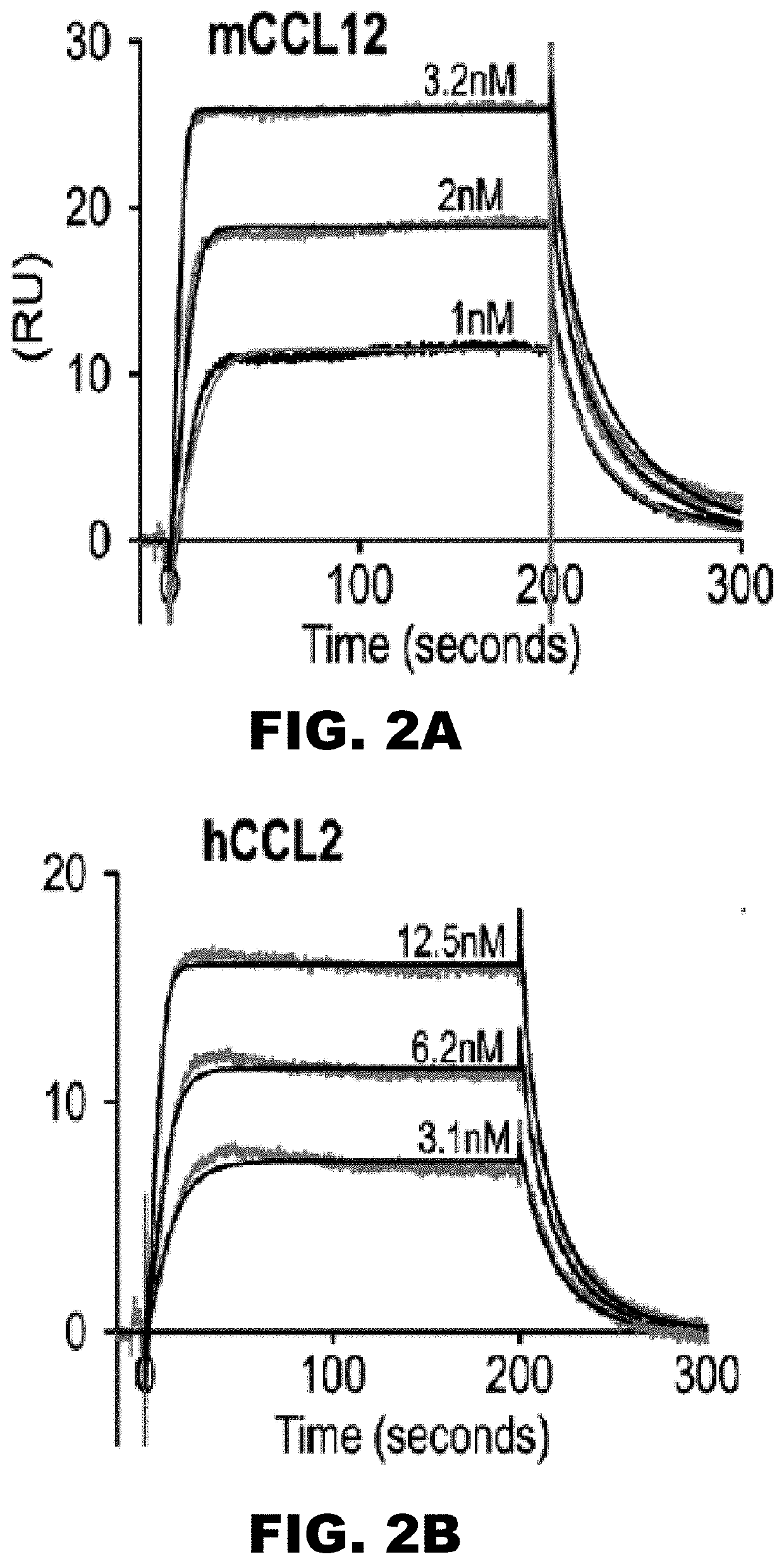Chemokine decoy receptors of rodent gammaherpesviruses and uses thereof
a gamma herpes virus and chemokine decoy technology, applied in the field of immunology, can solve the problems of early graft dysfunction, poor overall graft outcome, and infiltration of neutrophils, and achieve the effects of reducing the number of chemokine decoy receptors
- Summary
- Abstract
- Description
- Claims
- Application Information
AI Technical Summary
Benefits of technology
Problems solved by technology
Method used
Image
Examples
example 1
R17 Binds CC and C Chemokines with High Affinity
[0146]To assess the ability of R17 to directly interact with chemokines, a large panel of different chemokines and cytokines using surface plasmon resonance (SPR) were screened (FIG. 2A-FIG. 2E). In these experiments, R17 was covalently coupled to a BlAcore CM5 chip and examined for specific ligand binding. C-terminal Fc or His was not used for immobilization, because highly charged chemokines nonspecifically interact with antibodies necessary to capture proteins either by Fc or His tag. Of the 25 mouse and human chemokines tested, a concentration-dependent increase in the refractive index together with saturable binding was observed for mCCL2 and hCCL2, for mCCL3 and hCCL3, for mCCL4, mCCL5 and hCCL5, and for mCCL8, mCL11, mCCL20, mCCL24, mCCL19, mCCL12, and mXCL1. As negative controls for chemokine binding, either a NeutrAvidin-coupled chip or RHVP R7 were used; both of these proteins lack chemokine binding activity. From the SPR exp...
example 2
R17 Blocks Chemokine-Mediated Cell Migration
[0147]To address the functional consequences of R17-chemokine interactions, we performed experiments evaluating the migration of the human monocytic cell line THP-1 in response to hCCL2, a fast dissociating R17 ligand (KD,eq=12 nM, t1 / 2=2.1 s), and human PBMCs in response to hCCL3, a slow off-rate R17 ligand (KD,eq=1.4 nM, t1 / 2,app>1,000 s). We found that R17 potently blocked THP-1 cell transmigration when incubated in 10-fold molar excess of CCL2 (FIG. 3A). Similar disruption was observed when we incubated CCL2 with the M3 decoy receptor encoded by MHV68, which was previously shown to effectively block cell migration mediated by CCL19 and CCL21. As a negative control, we used RHVP R7 that lacks chemokine binding activity. Similar results were obtained when we examined the ability of R17 to disrupt CCL3-mediated transmigration of human PBMCs, where R17 and M3 proved inhibitory while R7 did not (FIG. 3B).
example 3
R17 Blocks Chemokine-Mediated Calcium Release
[0148]Activation of chemokine receptor signaling leads to calcium release from endoplasmic reticulum stores resulting in elevated levels of cytoplasmic calcium. Changes in calcium levels upon chemokine stimulation can be monitored in real time by Fura-2 dye-loaded cells. Previous experiments with MHV68 M3 revealed that it is an effective Ca2+ flux inhibitor for several distinct chemokines that it engages. We have tested the ability of R17 to inhibit transient increase in intracellular calcium induced by hCCL2 in THP-1 cells. When added in 10-fold molar excess, R17 effectively diminishes CCL2-mediated calcium flux, albeit not as effectively as M3, which forms significantly more stable complexes with CCL2 (FIG. 3C). The addition of a negative-control protein, MR-1, showed no changes in CCL2-mediated calcium mobilization. Together with the transmigration assays, these data suggest that R17 might function as an inhibitor of CC chemokine signa...
PUM
| Property | Measurement | Unit |
|---|---|---|
| weight fraction | aaaaa | aaaaa |
| weight fraction | aaaaa | aaaaa |
| weight fraction | aaaaa | aaaaa |
Abstract
Description
Claims
Application Information
 Login to View More
Login to View More - R&D
- Intellectual Property
- Life Sciences
- Materials
- Tech Scout
- Unparalleled Data Quality
- Higher Quality Content
- 60% Fewer Hallucinations
Browse by: Latest US Patents, China's latest patents, Technical Efficacy Thesaurus, Application Domain, Technology Topic, Popular Technical Reports.
© 2025 PatSnap. All rights reserved.Legal|Privacy policy|Modern Slavery Act Transparency Statement|Sitemap|About US| Contact US: help@patsnap.com



